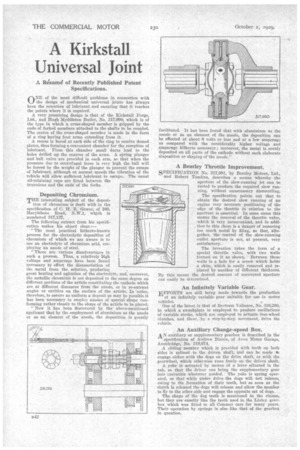Kirkstall Universal Joint
Page 76

If you've noticed an error in this article please click here to report it so we can fix it.
A Resume of Recently Published Patent Specifications.
ONEof the most difficult problems in connection with the design of mechanical universal joints has always been the retention of lubricant and ensuring that it reaches the points where :it is required.
A very promising design is that of the Kirkstall Forge, Ltd., and Hugh Myddleton Butler, No. 317,990, -which is of the type in which a cross-shaped member is gripped by the ends of forked members attached to the shafts to be coupled. The centre of the cross-shaped member is made in the form of a ring having four arms extending from it.
A recess is bored at each side of the ring to receive domed plates, thus forming a convenient chamber for the reception of lubricant. From this chamber small ducts lead to the boles drilled up the centres of the arms. A spring plunger and bail valve are provided in each arm, so that when the pressure due to centrifugal force is very high the ball will be forced by the-weight of the plunger to prevent the escape of lubricant, although at normal speeds the vibration of the vehicle will allow-sufficient lubricant to escape. The usual oil-retaining caps are fitted between the trunnions and the ends of the forks.
Depositing Chromium. THE interesting subject of the deposi
tion of chromium is dealt with in the specification of C. H: It: Gower, of 160, Marylebone Road, N.W.1, which is numbered 317,137.
The following extract from his specification makes his object clear :— " The most practical hitherto-known process for the electrolytic deposition of chromium of which we are aware is to use an electrolyte of chromium acid, employingan anode of steel.
" There arevarious disadvantages in such a Process. Thus, a relatively high voltage and amperage have been found necessary to effect the disassociation of the metal from the solution, producing great heating and agitation of the electrolyte, and, moreover, the metallic chromium is not deposited to the same degree on different portions of the article constituting the cathode which are at different distances from the anode, or in re-entrant angles or cavities on the surface of the article. In order, therefore, to secure as uniforin a deposit as may be possible it has been necessary to employ anodes of 'special shape conforming rather closely to the shape of the article to be plated.
"Now it has been discovered by the above-mentioned applicant that by the employment of aluminium as the anode or as an element of the anode, the deposition is greatly facilitated. It has been found that with aluminium as the anode or as an element of the anode, the deposition can be effected at about 6 volts or less and at a low amperage as compared with the considerably higher voltage and amperage hitherto necessary; moreover, the metal is evenly deposited on all parts of the cathode without such elaborate disposition or shaping of the anode." .
A Bentley Throttle Improvement.
SPECIEICATIox No. 317,991, by Bentley Motors, Ltd., and Robert Tomlins, describes a means whereby the aperture of the slow-running jet can be varied to produce the required slow running, without unnecessary dismantling. The specification points out that to obtain the desired slow running of an engine very accurate positioning of the edge of the throttle in relation to the aperture is essential. In some cases this means the removal of the throttle valve, which is very inconvenient, and in addition to this there is a danger of removing too much metal by filing, so that, altogether, the control 'of the slow-running outlet aperture is not, at present, very satisfactory.
The invention takes the form of a sPecial throttle valve, with two walls formed on it as 'shown. Between these walls is a hole for a screw which holds a shim, which is easily removed and re. placed by another of different thickness. By this means the desired amount of uncovered aperture can easily be determined.
An Infinitely Variable Gear.
EFFORTS are still being made towards the production of an infinitely variable gear suitable for use in motor vehicles.
One of the latest is that of Bertram Valiance, No. 316,280, in which a swashplate is employed to produce oscillations of variable stroke, which are employed to actuate free-wheel clutches, and these, by a step-by-step movement, drive the vehicle.
An Auxiliary Change-speed Box.
AN auxiliary or supplementary gearbox is described in the specification of Andrew Binnie, of Avon Motor Garage, Axonbridge, No. 318,074.
A sliding member which is Provided with teeth on both sides is splined to the driven shaft, and can be made lb engage either, with the dogs on the drive shaft, or with the gearwheel, which otherwise runs freely on the driven shaft.
A yoke is actuated by , means of a lever situated in the cab, so that the driver can bring the supplementary gear into aperation whenever needed. The yoke is spring operated, so that while under drive the dogs will not release, owing to the formation of their teeth, but so soon as the clutch is released the dogs will release and allow the member to fly to the other side and engage the opPosite set of dogs.,..
The shape of the dog teeth is mentioned in the claims, but they are exactly like the teeth used in.the Linley gearbox which was fitted to all Commer cars for many years. Their operation by springs is also like that of the gearbox in question.






















































































































